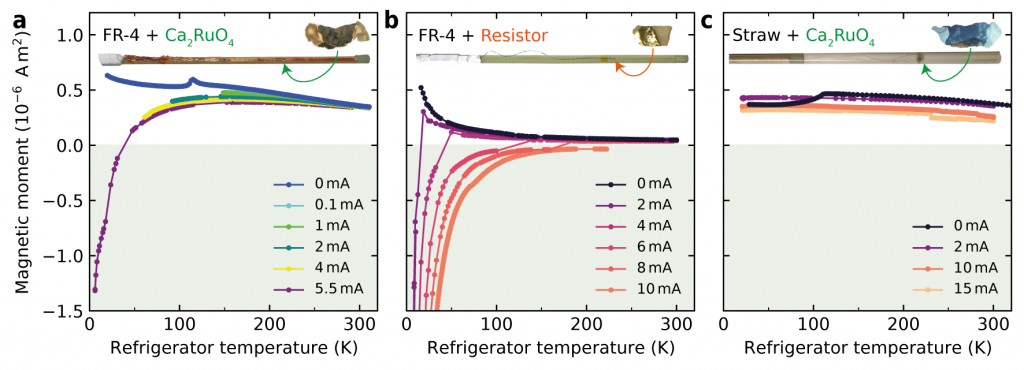Our reports on current-induced “diamagnetism”
In 2017, our group reported the insurgence of very large diamagnetism, a phenomenon where a sample shows a magnetisation in the direction antiparallel to the applied magnetic field. The diamagnetism was appearing in the Mott insulator Ca2RuO4 when a current of a few mA was applied to the material while cooling it below 50 K [1]. In 2019, we reported a similar effect to occur also in the related compound Ca3(Ru1-xTi)2O7 [2].
Local temperature increase responsible for the diamagnetic-like signals
While doing subsequent experiments on these phenomena, we now found that a serious artefact was affecting our experimental data. Namely, a local temperature increase in the sample holder was leading to a large and extrinsic diamagnetic-like signal. The local temperature increase was caused by the Joule heating of the current flowing through the sample. We have always been aware of the existence of Joule heating in the sample, and for this reason we carefully designed a special sample holder to efficiently cool down the sample and to accurately measure its temperature. However, the fact that localised heating of the sample holder could give a magnetic signal was rather unexpected and it was not considered before. Further investigation led us to reveal the details of this extrinsic “diamagnetic” signal, which we explained in a new publication [3].
After this finding, we attempted to provide an experimental demonstration that a local temperature increase of the sample holder can produce a large diamagnetic signal. For this purpose, we put a heater (an ordinary resistor) onto the glass epoxy sample holder used in Refs. [1] and [2] and induced a local heating via the Joule effect. We measured the resulting “magnetisation” with our SQUID magnetometer, as presented in Fig. 1b below. As one can see, in this configuration a diamagnetic-like signal can be induced by applying current to an ordinary heater, without using any special materials. Fig. 1a shows that the size of this “diamagnetism” is comparable to what reported in Refs. [1] and [2].
Moreover, we tried to re-measure Ca2RuO4 by using a different sample holder, namely one with a small magnetic background (a thin plastic straw). In this configuration, current-induced “diamagnetism” was not observed (Fig. 1c). We comment that the measurements of Fig. 1c are preliminary since the sample cooling could have been rather poor as a drawback effect of reducing the mass and cooling power of the sample holder.

Paper retraction
The comparison of this data indicates that the current-induced “diamagnetism” reported in [1] and [2] is to a large extent due to an experimental artefact originating from the sample holder. For this reason, we retracted the papers [1] and [2] in April 2020. We are very sorry for reporting such extrinsic phenomena originating from a mechanism that we were not aware of. Among the coauthors, staff members of the Kyoto Univ. group (Maeno and Yonezawa) should be solely responsible for this mistake.
[1] C. Sow, S. Yonezawa, S. Kitamura, T. Oka, K. Kuroki, F. Nakamura, Y. Maeno, Science 358, 1084 (2017). *This paper has been retracted; See [Science 368, 376 (2020)]
[2] C. Sow, R. Numasaki, G. Mattoni, S. Yonezawa, N. Kikugawa, S. Uji, Y. Maeno, Phys. Rev. Lett. 122, 196602 (2019). *This paper has been retracted; See [Phys. Rev. Lett. 124, 169902 (2020)]
[3] G. Mattoni, S. Yonezawa, Y. Maeno, Appl. Phys. Lett. 116, 172405 (2020).
![]()
